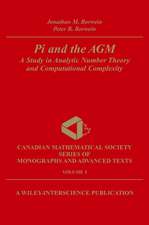Quadratic and Hermitian Forms: Grundlehren der mathematischen Wissenschaften, cartea 270
Autor W. Scharlauen Limba Engleză Paperback – 10 dec 2011
Din seria Grundlehren der mathematischen Wissenschaften
-
 Preț: 353.84 lei
Preț: 353.84 lei - 24%
 Preț: 728.15 lei
Preț: 728.15 lei -
 Preț: 410.21 lei
Preț: 410.21 lei - 24%
 Preț: 587.87 lei
Preț: 587.87 lei - 17%
 Preț: 498.73 lei
Preț: 498.73 lei -
 Preț: 592.75 lei
Preț: 592.75 lei - 20%
 Preț: 692.49 lei
Preț: 692.49 lei - 24%
 Preț: 893.28 lei
Preț: 893.28 lei - 20%
 Preț: 824.73 lei
Preț: 824.73 lei - 24%
 Preț: 632.96 lei
Preț: 632.96 lei - 15%
 Preț: 596.69 lei
Preț: 596.69 lei - 15%
 Preț: 714.49 lei
Preț: 714.49 lei -
 Preț: 333.01 lei
Preț: 333.01 lei - 15%
 Preț: 473.16 lei
Preț: 473.16 lei -
 Preț: 356.49 lei
Preț: 356.49 lei -
 Preț: 484.43 lei
Preț: 484.43 lei - 15%
 Preț: 452.79 lei
Preț: 452.79 lei -
 Preț: 456.66 lei
Preț: 456.66 lei - 15%
 Preț: 708.75 lei
Preț: 708.75 lei -
 Preț: 423.08 lei
Preț: 423.08 lei - 15%
 Preț: 444.29 lei
Preț: 444.29 lei - 15%
 Preț: 527.79 lei
Preț: 527.79 lei - 15%
 Preț: 589.65 lei
Preț: 589.65 lei -
 Preț: 353.40 lei
Preț: 353.40 lei - 18%
 Preț: 727.66 lei
Preț: 727.66 lei -
 Preț: 387.96 lei
Preț: 387.96 lei - 15%
 Preț: 454.74 lei
Preț: 454.74 lei - 15%
 Preț: 481.03 lei
Preț: 481.03 lei -
 Preț: 464.55 lei
Preț: 464.55 lei -
 Preț: 348.77 lei
Preț: 348.77 lei -
 Preț: 362.04 lei
Preț: 362.04 lei -
 Preț: 488.12 lei
Preț: 488.12 lei - 15%
 Preț: 447.57 lei
Preț: 447.57 lei -
 Preț: 419.81 lei
Preț: 419.81 lei -
 Preț: 388.52 lei
Preț: 388.52 lei -
 Preț: 419.21 lei
Preț: 419.21 lei - 15%
 Preț: 581.01 lei
Preț: 581.01 lei -
 Preț: 497.75 lei
Preț: 497.75 lei -
 Preț: 360.53 lei
Preț: 360.53 lei -
 Preț: 387.75 lei
Preț: 387.75 lei -
 Preț: 419.81 lei
Preț: 419.81 lei - 18%
 Preț: 725.75 lei
Preț: 725.75 lei -
 Preț: 453.78 lei
Preț: 453.78 lei -
 Preț: 386.39 lei
Preț: 386.39 lei
Preț: 896.70 lei
Preț vechi: 1093.53 lei
-18% Nou
Puncte Express: 1345
Preț estimativ în valută:
171.60€ • 178.93$ • 142.62£
171.60€ • 178.93$ • 142.62£
Carte tipărită la comandă
Livrare economică 21 martie-04 aprilie
Preluare comenzi: 021 569.72.76
Specificații
ISBN-13: 9783642699733
ISBN-10: 3642699731
Pagini: 436
Ilustrații: X, 422 p.
Dimensiuni: 155 x 235 x 23 mm
Greutate: 0.61 kg
Ediția:Softcover reprint of the original 1st ed. 1985
Editura: Springer Berlin, Heidelberg
Colecția Springer
Seria Grundlehren der mathematischen Wissenschaften
Locul publicării:Berlin, Heidelberg, Germany
ISBN-10: 3642699731
Pagini: 436
Ilustrații: X, 422 p.
Dimensiuni: 155 x 235 x 23 mm
Greutate: 0.61 kg
Ediția:Softcover reprint of the original 1st ed. 1985
Editura: Springer Berlin, Heidelberg
Colecția Springer
Seria Grundlehren der mathematischen Wissenschaften
Locul publicării:Berlin, Heidelberg, Germany
Public țintă
ResearchCuprins
1. Basic Concepts.- §1. Bilinear Forms and Quadratic Forms.- § 2. Matrix Notation.- § 3. Regular Spaces and Orthogonal Decomposition.- § 4. Isotropy and Hyperbolic Spaces.- §5. Witt’s Theorem.- §6. Appendix: Symmetric Bilinear Forms and Quadratic Forms over Rings.- 2. Quadratic Forms over Fields.- §1. Grothendieck and Witt Rings.- §2. Invariants.- § 3. Examples I (Finite Fields).- § 4. Examples II (Ordered Fields).- § 5. Ground Field Extension and Transfer.- §6. The Torsion of the Witt Group.- §7. Orderings, Pfister’s Local Global Principle, and Prime Ideals of the Witt Ring.- § 8. Applications of the Method of Transfer.- § 9. Description of the Witt Ring by Generators and Relations.- § 10. Multiplicative Forms.- §11. Quaternion Algebras.- §12. The Hasse Invariant and the Witt Invariant.- §13. The Hasse Algebra.- § 14. Classification Theorems.- §15. Examples III. Ci-fields.- §16. The u-invariant.- 3. Quadratic Forms over Formally Real Fields.- §1. Formally Real and Ordered Fields.- §2. Real Closed Fields.- §3. Hilbert’s 17th Problem and the Real Nullstellensatz.- §4. Extension of Signatures.- §5. The Space of Orderings of a Field.- §6. The Total Signature.- §7. A Local Global Principle for Weak Isotropy.- Appendix: Places, Valuations, and Valuation Rings.- 4. Generic Methods and Pfister Forms.- §1. Chain-p-equivalence of Pfister Forms.- § 2. Pfister’s Theorem on the Representation of Positive Functions as Sums of Squares.- §3. Casseis’ and Pfister’s Representation Theorems.- §4. Applications: Fields of Prescribed Level. Characterization of Pfister Forms.- §5. The Function Field of a Quadratic Form and the Main Theorem of Arason and Pfister.- §6. Generic Zeros and Generic Splitting.- §7. Knebusch’s Filtration of the WittRing.- 5. Rational Quadratic Forms.- § 1. Symmetric Bilinear Forms and Quadratic Forms on Finite Abelian Groups.- §2. Gaussian Sums for Quadratic Forms on Finite Abelian Groups.- §3. The Witt Group of1.- §4. The Witt Group of 2.- §5. Gauss’ First Proof of the Quadratic Reciprocity Law.- §6. Quadratic Forms over the p-adic Numbers.- §7. Hilbert’s Reciprocity Law and the Hasse-Minkowski Theorem.- §8. Calculation of Gaussian Sums.- 6. Symmetric Bilinear Forms over Dedekind Rings and Global Fields.- §1. Symmetric Bilinear Forms over Dedekind Rings.- § 2. Symmetric Bilinear Forms over Discrete Valuation Rings.- §3. Symmetric Bilinear Forms over Polynomial Rings and Rational Function Fields.- §4. Symmetric Bilinear Forms over p-adic Fields.- § 5. The Hilbert Reciprocity Theorem.- § 6. The Hasse-Minkowski Theorem.- § 7. Hecke’s Theorem on the Different.- §8. The Residue Theorem.- 7. Foundations of the Theory of Hermitian Forms.- §1. Basic Definitions.- § 2. Hermitian Categories.- § 3. Quadratic Forms.- §4. Transfer and Reduction.- § 5. Hermitian Abelian Categories.- §6. Hermitian Forms over Skew Fields.- §7. Hyperbolic Forms and the Unitary Group.- §8. Alternating Forms and the Symplectic Group.- §9. Witt’s Theorem.- § 10. The Krull-Schmidt Theorem.- §11. Examples and Applications.- 8. Simple Algebras and Involutions.- §1. Simple Rings and Modules.- §2. Tensor Products.- § 3. Central Simple Algebras. The Brauer Group.- §4. Simple Algebras.- §5. Central Simple Algebras under Field Extensions. Reduced Norms and Traces.- §6. Examples.- §7. Involutions on Simple Algebras. The Classification Problem.- § 8. Existence of Involutions.- §9. The Corestriction. Existence of Involutions of the Second Kind.- § 10. An Extension Theorem forInvolutions.- §11. Quaternion Algebras.- §12. Cyclic Algebras.- §13. The Canonical Involution on the Group Algebra.- 9. Clifford Algebras.- §1. Graded Algebras.- §2. Clifford Algebras.- § 3. The Spinor Norm.- §4. Quadratic Forms over Fields in Characteristic 2.- 10. Hermitian Forms over Global Fields.- §1. Hermitian Forms over Commutative Fields and Quaternion Algebras.- §2. Simple Algebras and Involutions over Local and Global Fields.- §3. Skew Hermitian Forms over Quaternion Fields.- §4. Skew Hermitian Forms over Global Quaternion Fields..- §5. The Strong Approximation Theorem.- §6. Hermitian Forms for Unitary Involutions. Statement of Results.- §7. Proof of the Weak Local Global Principle.- §8. Conclusion of the Proof.













